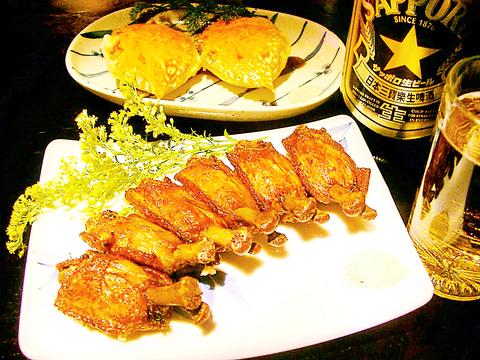Most people think of Japanese restaurants as posh establishments serving up fancy food with a very light taste. But the Japanese grill shop 12 Yaki offers you juicy meats in rich and strong sauces washed down with beer or sake in a cozy atmosphere. It is the perfect way to drive away the winter cold.
The popularity of Taipei's Japanese-style grill houses has been growing rapidly. This has largely been the result of the "all-you-can-eat" and "do-it-yourself" concept "yakiniku" restaurants where you grill sliced meat at your table. 12 Yaki is a "yakitori" restaurant, which, although it sounds the same, is a different kettle of fish altogether.

PHOTO: YU SEN-LUN, TAIPEI TIMES
In Japan, yakitori is a synonym for Japanese pub-style cuisine. Office workers visit yakitori shops after work to have a few drinks. The food is generally strongly flavored to meet the tastes of drinkers.
"Yakitori" means grilled bird in Japanese, so it is no surprise that chicken is the main dish, with just a few red meat dishes and seafoods thrown in to fill out the menu. Food is grilled on skewers in the kitchen and then served.
Restaurant owner Wang Wei-shun (
In his small restaurant, tables are close together and it is easy to mingle. Wang knows many of the guests personally. He has even been matchmaker for a couple who met there and are now getting married. More recently the already popular restaurant gained still more fame as the place Chu Hsiao-tien (
However, it is the food that 12 Yaki is really about. tulip chicken wing (
There are two popular fried dishes: seafood croquette and crispy crab. The former uses cabbage to wrap shrimp and fish which is then coated with egg and bread crumbs before being deep fried.
The latter is a very complex dish to prepare, requiring that the meat is first removed from the shell, seasoned and then put back. The whole thing is then deep fried until crispy. On a Friday night, this dish is in such heavy demand that it quickly runs out.
Reservations are recommended not simply to get a seat, but also because you are treated to a free cold dish if you reserve a place by phone.

“Why does Taiwan identity decline?”a group of researchers lead by University of Nevada political scientist Austin Wang (王宏恩) asked in a recent paper. After all, it is not difficult to explain the rise in Taiwanese identity after the early 1990s. But no model predicted its decline during the 2016-2018 period, they say. After testing various alternative explanations, Wang et al argue that the fall-off in Taiwanese identity during that period is related to voter hedging based on the performance of the Democratic Progressive Party (DPP). Since the DPP is perceived as the guardian of Taiwan identity, when it performs well,

The Taiwan People’s Party (TPP) on May 18 held a rally in Taichung to mark the anniversary of President William Lai’s (賴清德) inauguration on May 20. The title of the rally could be loosely translated to “May 18 recall fraudulent goods” (518退貨ㄌㄨㄚˋ!). Unlike in English, where the terms are the same, “recall” (退貨) in this context refers to product recalls due to damaged, defective or fraudulent merchandise, not the political recalls (罷免) currently dominating the headlines. I attended the rally to determine if the impression was correct that the TPP under party Chairman Huang Kuo-Chang (黃國昌) had little of a

At Computex 2025, Nvidia CEO Jensen Huang (黃仁勳) urged the government to subsidize AI. “All schools in Taiwan must integrate AI into their curricula,” he declared. A few months earlier, he said, “If I were a student today, I’d immediately start using tools like ChatGPT, Gemini Pro and Grok to learn, write and accelerate my thinking.” Huang sees the AI-bullet train leaving the station. And as one of its drivers, he’s worried about youth not getting on board — bad for their careers, and bad for his workforce. As a semiconductor supply-chain powerhouse and AI hub wannabe, Taiwan is seeing

Jade Mountain (玉山) — Taiwan’s highest peak — is the ultimate goal for those attempting a through-hike of the Mountains to Sea National Greenway (山海圳國家綠道), and that’s precisely where we’re headed in this final installment of a quartet of articles covering the Greenway. Picking up the trail at the Tsou tribal villages of Dabang and Tefuye, it’s worth stocking up on provisions before setting off, since — aside from the scant offerings available on the mountain’s Dongpu Lodge (東埔山莊) and Paiyun Lodge’s (排雲山莊) meal service — there’s nowhere to get food from here on out. TEFUYE HISTORIC TRAIL The journey recommences with